初中英语语法中it的用法学习资料
- 格式:ppt
- 大小:144.50 KB
- 文档页数:11
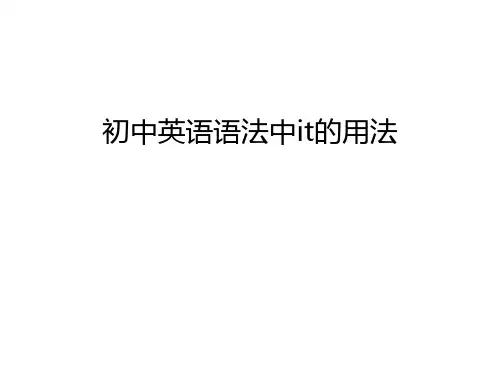
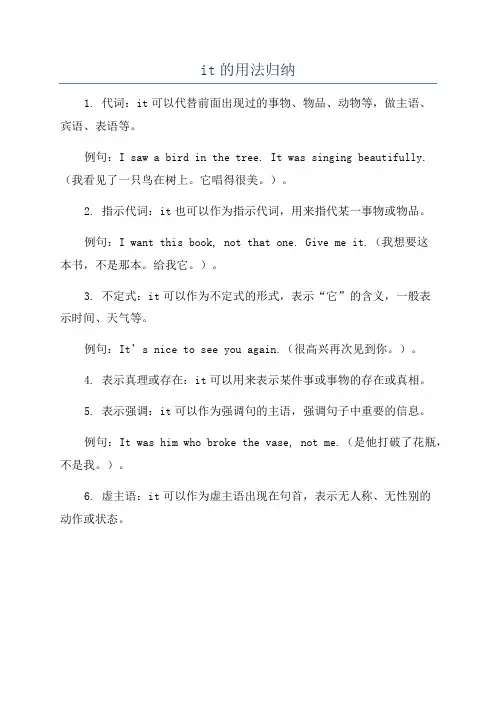
it的用法归纳
1. 代词:it可以代替前面出现过的事物、物品、动物等,做主语、
宾语、表语等。
例句:I saw a bird in the tree. It was singing beautifully. (我看见了一只鸟在树上。
它唱得很美。
)。
2. 指示代词:it也可以作为指示代词,用来指代某一事物或物品。
例句:I want this book, not that one. Give me it.(我想要这
本书,不是那本。
给我它。
)。
3. 不定式:it可以作为不定式的形式,表示“它”的含义,一般表
示时间、天气等。
例句:It’s nice to see you again.(很高兴再次见到你。
)。
4. 表示真理或存在:it可以用来表示某件事或事物的存在或真相。
5. 表示强调:it可以作为强调句的主语,强调句子中重要的信息。
例句:It was him who broke the vase, not me.(是他打破了花瓶,不是我。
)。
6. 虚主语:it可以作为虚主语出现在句首,表示无人称、无性别的
动作或状态。
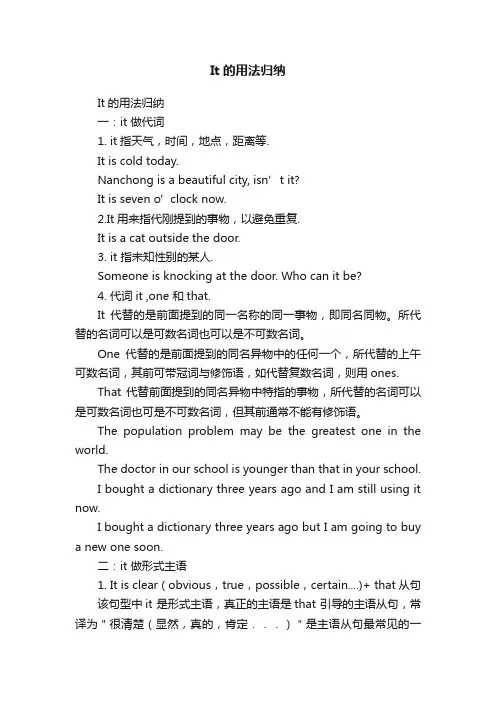
It的用法归纳It的用法归纳一:it 做代词1. it指天气,时间,地点,距离等.It is cold today.Nanchong is a beautiful city, isn’t it?It is seven o’clock now.2.It用来指代刚提到的事物,以避免重复.It is a cat outside the door.3. it 指未知性别的某人.Someone is knocking at the door. Who can it be?4. 代词it ,one 和that.It代替的是前面提到的同一名称的同一事物,即同名同物。
所代替的名词可以是可数名词也可以是不可数名词。
One代替的是前面提到的同名异物中的任何一个,所代替的上午可数名词,其前可带冠词与修饰语,如代替复数名词,则用ones.That 代替前面提到的同名异物中特指的事物,所代替的名词可以是可数名词也可是不可数名词,但其前通常不能有修饰语。
The population problem may be the greatest one in the world.The doctor in our school is younger than that in your school.I bought a dictionary three years ago and I am still using it now.I bought a dictionary three years ago but I am going to buya new one soon.二:it 做形式主语1. It is clear ( obvious,true,possible,certain....)+ that从句该句型中it 是形式主语,真正的主语是that 引导的主语从句,常译为"很清楚(显然,真的,肯定...)"是主语从句最常见的一种结构。
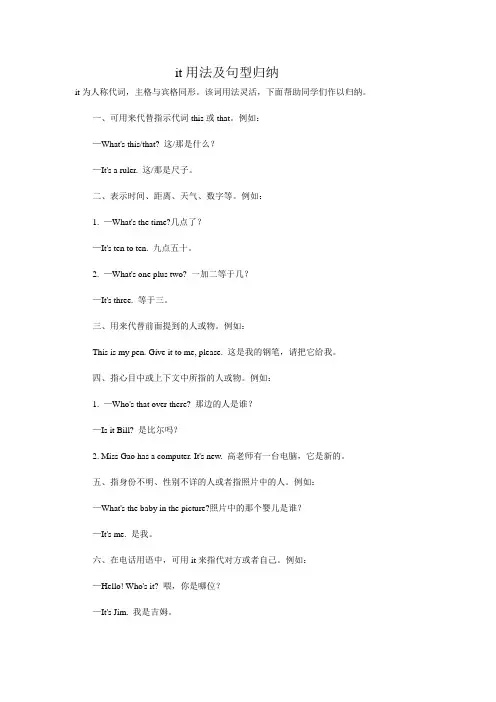
it用法及句型归纳it为人称代词,主格与宾格同形。
该词用法灵活,下面帮助同学们作以归纳。
一、可用来代替指示代词this或that。
例如:—What's this/that? 这/那是什么?—It's a ruler. 这/那是尺子。
二、表示时间、距离、天气、数字等。
例如:1. —What's the time?几点了?—It's ten to ten. 九点五十。
2. —What's one plus two? 一加二等于几?—It's three. 等于三。
三、用来代替前面提到的人或物。
例如:This is my pen. Give it to me, please. 这是我的钢笔,请把它给我。
四、指心目中或上下文中所指的人或物。
例如:1. —Who's that over there? 那边的人是谁?—Is it Bill? 是比尔吗?2. Miss Gao has a computer. It's new. 高老师有一台电脑,它是新的。
五、指身份不明、性别不详的人或者指照片中的人。
例如:—What's the baby in the picture?照片中的那个婴儿是谁?—It's me. 是我。
六、在电话用语中,可用it来指代对方或者自己。
例如:—Hello! Who's it? 喂,你是哪位?—It's Jim. 我是吉姆。
在初中英语教材中,出现了许多由it引导的固定句式,现归纳如下:一、It's time for sb. to do sth. / It's time for sth.意为"是(某人)该干……的时间了"、"到……的时候了"。
例如:1. It's time for supper /to have supper.该吃晚饭了。
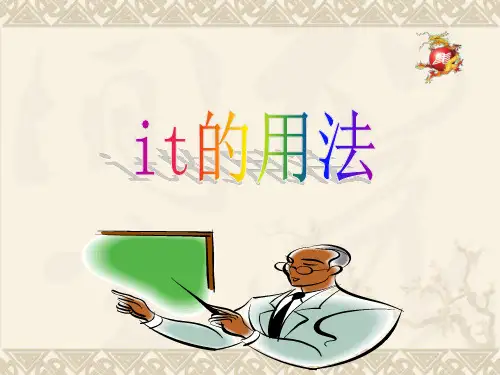
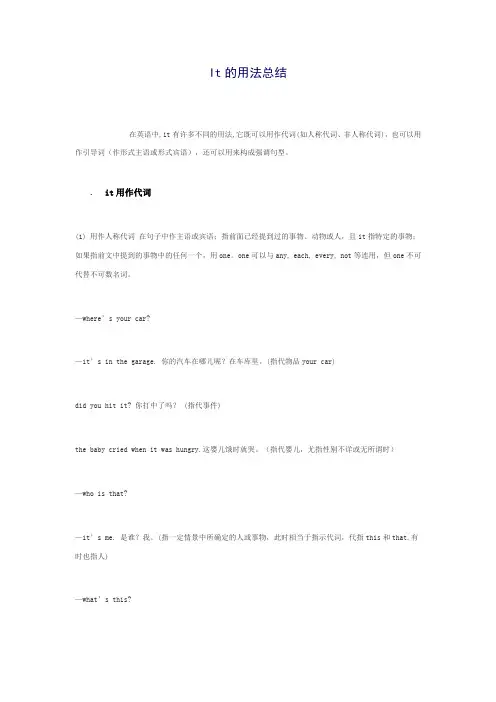
It的用法总结在英语中,it有许多不同的用法,它既可以用作代词(如人称代词、非人称代词),也可以用作引导词(作形式主语或形式宾语),还可以用来构成强调句型。
.it用作代词(1) 用作人称代词在句子中作主语或宾语;指前面已经提到过的事物、动物或人,且it指特定的事物;如果指前文中提到的事物中的任何一个,用one。
one可以与any, each, every, not等连用,但one不可代替不可数名词。
—where’s your car?—it’s in the garage. 你的汽车在哪儿呢?在车库里。
(指代物品your car)did you hit it? 你打中了吗? (指代事件)the baby cried when it was hungry.这婴儿饿时就哭。
(指代婴儿,尤指性别不详或无所谓时)—who is that?—it’s me. 是谁?我。
(指一定情景中所确定的人或事物,此时相当于指示代词,代指this和that,有时也指人)—what’s this?—it’s a box. 这是什么?一只箱子。
(2) 作非人称代词表示天气、日期、时间、温度、距离、价值、路程、度量、自然现象与环境等。
也可模糊地指一般情形或上文的部分或整个意思。
译成汉语时,it通常不一定译出来。
it’s a long time since they left. 他们走后很久了。
it’s two miles to the beach.离海滨有两英里远。
that’s just it—i can’t work when you’re making so much noise.原因就在这里——你弄出这么大的声音,我工作不了。
另外,需要注意两点:(1)“it’s time…”后面可以接不定式和介词短语表示“是做……的时候了”。
如:it’s time for supper. it’s time to have supper.(2) “it’s time…”后面还可以接一个从句,但是从句中的谓语动词一定要用过去式即虚拟语气,如:it’s time we had lunch.是我们吃饭的时候了。
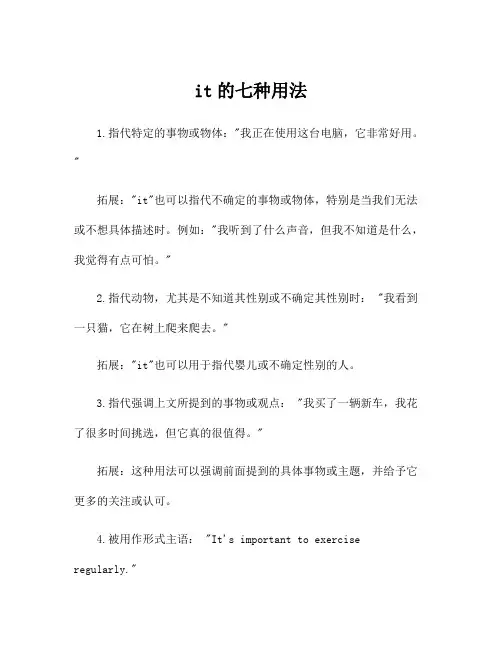
it的七种用法1.指代特定的事物或物体:"我正在使用这台电脑,它非常好用。
"拓展:"it"也可以指代不确定的事物或物体,特别是当我们无法或不想具体描述时。
例如:"我听到了什么声音,但我不知道是什么,我觉得有点可怕。
"2.指代动物,尤其是不知道其性别或不确定其性别时: "我看到一只猫,它在树上爬来爬去。
"拓展:"it"也可以用于指代婴儿或不确定性别的人。
3.指代强调上文所提到的事物或观点: "我买了一辆新车,我花了很多时间挑选,但它真的很值得。
"拓展:这种用法可以强调前面提到的具体事物或主题,并给予它更多的关注或认可。
4.被用作形式主语: "It's important to exercise regularly."拓展:在某些句子中,"it"可以用作形式主语,代表主语部分的内容,尤其是当真正的主语是以后出现时。
5.引导强调句: "It was John who broke the vase."拓展:在强调句中,"it"被用作形式主语,而真正的主语将被放置在句子的后部,以便强调。
6.用于指示时间、天气和环境条件: "It's raining outside."拓展:"it"在描述天气、时间或条件时,常用于英语中,例如:"It's getting late." "It's hot today."7.在某些习语中,表示状态或情感: "I'm over it." (我已经度过了这个困境)拓展:在某些习语或俚语中,"it"用于表示情感、状态或体验,并在一定程度上代表所描述的特定情况。
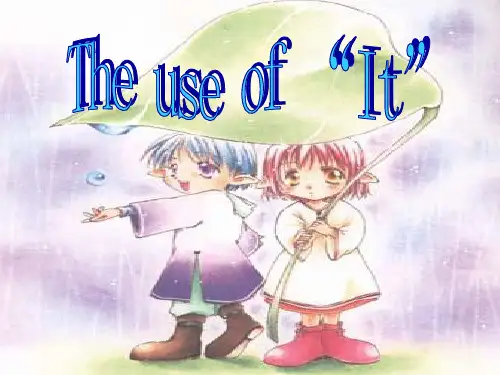
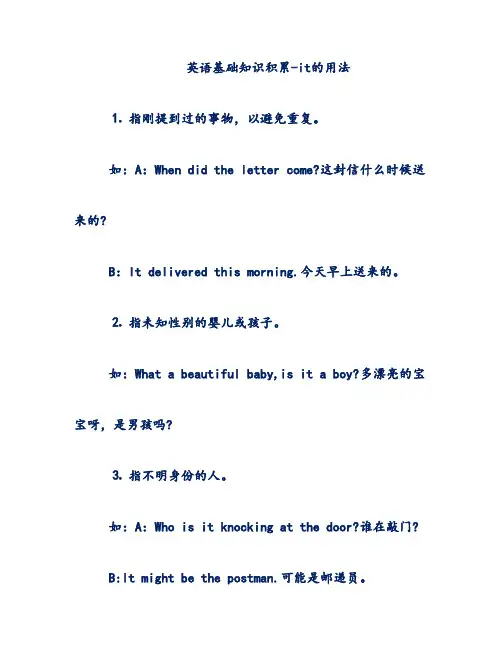
英语基础知识积累-it的用法⒈指刚提到过的事物,以避免重复。
如:A:When did the letter come?这封信什么时候送来的?B:It delivered this morning.今天早上送来的。
⒉指未知性别的婴儿或孩子。
如:What a beautiful baby,is it a boy?多漂亮的宝宝呀,是男孩吗?⒊指不明身份的人。
如:A:Who is it knocking at the door?谁在敲门?B:It might be the postman.可能是邮递员。
⒋指时间或季节。
如:It is ten o'clock.现在是十点钟。
It is late autumn.现在已是深秋了。
⒌指天气,环境。
如:It's raining hard outside.外面雨下得正大。
It is noisy in here.这里很嘈杂。
⒍指距离。
如:It is half an hour's walk to the city centre.走到市中心只需半小时。
⒎用于形式主语或形式宾语。
简单句:It is hard to learn English well.(it做形式主语,真正主语是learn English)I find it hard to learn English well.(hard为宾语补足语,语义上的补充)(it做形式宾语,真正宾语是learn English)复合句:I find(that)it is hard to learn English well宾语从句)(主句是I find……,系表为it is引导的从句)⒏用于强调结构中,不作任何成分注意:在强调结构中,不能强调谓语部分。
It is/was...that/who...如:The students are learning grammar in theclassroom now.→It is the students who are learning grammar in the classroom now.→It is grammar that the students are learning in the classroom now.→It is in the classroom that the students are learning grammar now.→It is now that the students are learning grammar in the classroom.⒐用来代替上文提到过的句子。
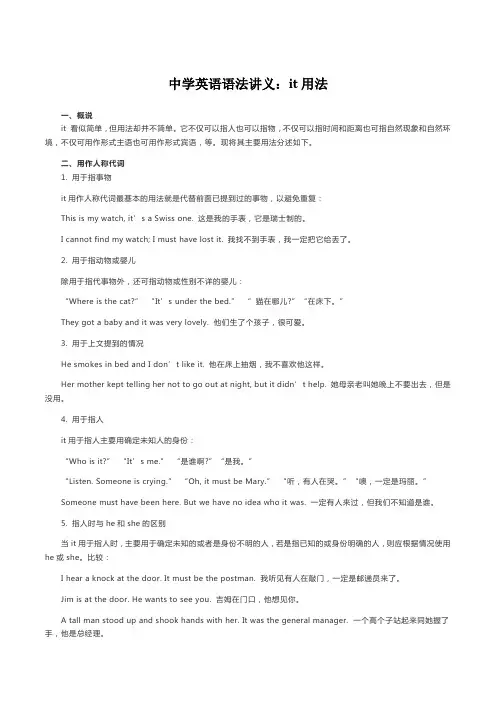
中学英语语法讲义:it用法一、概说it 看似简单,但用法却并不简单。
它不仅可以指人也可以指物,不仅可以指时间和距离也可指自然现象和自然环境,不仅可用作形式主语也可用作形式宾语,等。
现将其主要用法分述如下。
二、用作人称代词1. 用于指事物it用作人称代词最基本的用法就是代替前面已提到过的事物,以避免重复:This is my watch, it’s a Swiss one. 这是我的手表,它是瑞士制的。
I cannot find my watch; I must have lost it. 我找不到手表,我一定把它给丢了。
2. 用于指动物或婴儿除用于指代事物外,还可指动物或性别不详的婴儿:“Where is the cat?”“It’s under the bed.”“猫在哪儿?”“在床下。
”They got a baby and it was very lovely. 他们生了个孩子,很可爱。
3. 用于上文提到的情况He smokes in bed and I don’t like it. 他在床上抽烟,我不喜欢他这样。
Her mother kept telling her not to go out at night, but it didn’t help. 她母亲老叫她晚上不要出去,但是没用。
4. 用于指人it用于指人主要用确定未知人的身份:“Who is it?”“It’s me.”“是谁啊?”“是我。
”“Listen. Someone is crying.”“Oh, it must be Mary.”“听,有人在哭。
”“噢,一定是玛丽。
”Someone must have been here. But we have no idea who it was. 一定有人来过,但我们不知道是谁。
5. 指人时与he和she的区别当it用于指人时,主要用于确定未知的或者是身份不明的人,若是指已知的或身份明确的人,则应根据情况使用he或she。
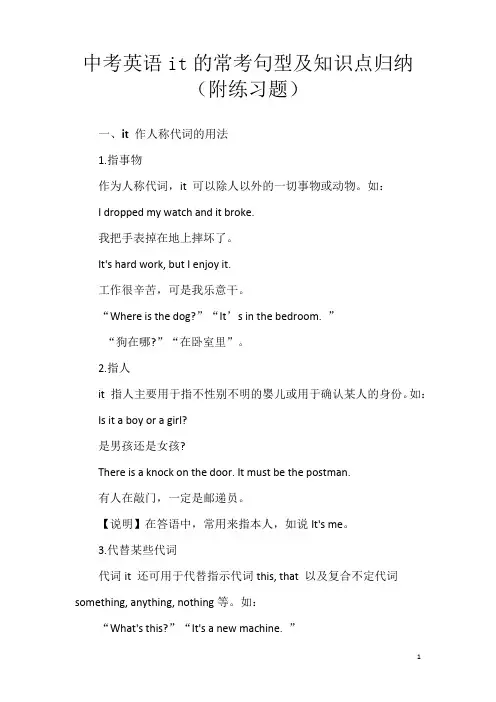
中考英语it的常考句型及知识点归纳(附练习题)一、it 作人称代词的用法1.指事物作为人称代词,it 可以除人以外的一切事物或动物。
如:I dropped my watch and it broke.我把手表掉在地上摔坏了。
It's hard work, but I enjoy it.工作很辛苦,可是我乐意干。
“Where is the dog?”“It’s in the bedroom. ”“狗在哪?”“在卧室里”。
2.指人it 指人主要用于指不性别不明的婴儿或用于确认某人的身份。
如:Is it a boy or a girl?是男孩还是女孩?There is a knock on the door. It must be the postman.有人在敲门,一定是邮递员。
【说明】在答语中,常用来指本人,如说It's me。
3.代替某些代词代词it 还可用于代替指示代词this, that 以及复合不定代词something, anything, nothing等。
如:“What's this?”“It's a new machine. ”“这是什么?”“是一种新机器”。
Nothing is wrong, is it?没出什么问题,是吗?二、it 作非人称代词的用法1.基本用法it 作非人称代词的用法,主要用于指时间、距离、价值、天气、气候及温度等自然现象。
如:It's too late to go there now.现在去那儿已经太迟了。
It rained all day yesterday.昨天下了一天的雨。
It can get very hot here.这里有时会很热。
2.用于某些句型It's time for sth.该做某事了。
It's time to do sth.该做某事的时候了。
It's time for sb to do sth.某人该干某事了。
2024年初中中考英语专项学习之it 的用法•“It”用法及其句型和固定搭配,是英语语法的重点、难点,又是近几年考试的热点,因此在复习中应给予足够的重视。
•It用法小结:•作为代词,表示“它”或“那”。
例如:•It is a beautiful day today.(今天是个美丽的日子。
)•It is a long way to the airport, isn't it?(去机场的路很远,是吧?)•作为形式主语,用于避免重复使用主语。
例如:•I am going to buy some new books, it is necessary to read more.(我需要读更多的书,这是有必要的。
)•She is studying to be a doctor, it is challenging but exciting.(她正在为成为一名医生而努力,这是有挑战但令人兴奋的事情。
)•作为插入语,用于强调某个句子中的某个部分。
例如:•It was raining cats and dogs when we arrived at the park.(我们到达公园时正在下倾盆大雨。
)•It is said that he will be back tomorrow.(据说他明天回来。
)•作为宾语,用于表示某事发生的情况。
例如:•It is time for us to go home.(是时候回家了。
)•It is important to follow the rules in our school.(在我们的学校遵守规则很重要。
)•作为定语,用于修饰名词。
例如:•It's a beautiful house.(这是一个漂亮的房子。
)•It is necessary to take a shower before using the computer.(在使用电脑前要洗个澡是必要的。
英语中it用法全解析摘要本文主要介绍了英语中it的用法,包括以下几个方面:it作为人称代词,指代前文提到的或语境中明确的人或物。
it作为非人称代词,表示天气、时间、温度、距离等抽象概念。
it作为形式主语或形式宾语,代替不定式、动名词或从句等真正的主语或宾语。
it用于强调句型,突出句子中的某一成分。
it用于其他常见的句式和短语,表达不同的意思和功能。
1. it作为人称代词it作为人称代词,通常指代前文提到的或语境中明确的人或物。
它在句中可以作主语、宾语、定语或表语等。
例如:句子说明He took a quick look at the house and noticed it was veryold.it指代前文提到的house,作主语。
John hates children, and it is difficult to say why.it指代前面提到的事情,作主语。
She made it clear (that) we were not welcome.it作形式宾语,真正的宾语是that引导的从句。
It's me.it作形式主语,真正的主语是me。
2. it作为非人称代词it作为非人称代词,表示天气、时间、温度、距离等抽象概念。
它在句中通常作主语或宾语。
例如:句子说明It is raining.it表示天气,作主语。
It is an hour's walk from my home to the school.it表示距离,作主语。
It is a pity that I didn't think of it earlier.it表示一般情况,作主语。
I don't like it when you are angry.it指代后面的when引导的从句,作宾语。
3. it作为形式主语或形式宾语当不定式、动名词或从句等用作主语或宾语时,为避免头重脚轻或保持句子平衡,通常在句首使用形式主语或形式宾语it,而把真正的主语或宾语置于句尾。
it的用法1.It用作代词:用来指代前面提到的事情,是单数。
(1)用作人称代词,代替上文提到的人或事物。
e.g. ——Who is it?——It’s me. You’ve helped me a lot; I’ll never forget it.(2) 用以代替指示代词this或that。
e.g. ①——What’s this?——It’s a computer.②——Whose book is that?——It's hers.(3)表示时间、天气、距离、价钱等。
e.g. It’s time for lunch.It’s raining hard.It’s two miles from the school to our home.(4)在不清楚性别的情况下也可以用来指代人。
e.g. ——Someone comes to visit you at the gate of the school.——Who is it?2. it作形式主语(1)It is + difficult/ hard / easy / important / necessary + for sb. to do sth. 干某事对某人来说是怎么样的。
(2)It is + kind / good / nice / clever of sb. to do sth. 某人做某事是怎么样的。
e.g. It is useful for you to learn English well.It’s too hard to understand spoken English.It is important for us to protect the environment.It’s very kind of you to help m e.(3)主语从句:that引导的主语从句既可放在句首,也可放在句末。
但是为了保持句子的平衡,常用it作形式主语,把真正的主语从句放在句后;e.g. That he is a doctor is true.=It is true that he is a doctor.It is surprising that she is so angry.That he survived the accident is a miracle.=It is a miracle that he survived the accident.①It + be +名词+ that从句;e.g. It is a fact that…It is common sense that…It’s a pity/a shame/a question/ an honor/a wonder…that…②It + be +形容词+ that从句;e.g. It is certain/clear/evident/likely/probable/better/natural that…③It + be +过去分词+ that从句;e.g. It is said/demanded/believed/reported/estimated that…④It +不及物动词+ that从句e.g. It seems/happened/follows/matters/occurred to me/struck to me that…(4) It is + 序数词+time that从句(用现在完成时).It was + 序数词+time that从句(用现在完成时).e.g. It is the first time that I have seen the movie.It was the third time that Tom had come to the place.(5)专题练习①It is high time _______ us to do something to improve our environment.②It is the first time that the girl ____________(see)a panda.③Believe me, I know how easy it is to begin smoking and how tough _______ is to stop.④It is no use _________ (argue )with Bill because he will never change his mind.3. it作形式宾语(1)find / feel / think+ it + 形容词+ to do sth. 发现/感到/认为干某事是怎么样的e.g. Why did Wei Fen find it difficult to learn English?I find it difficult (for Lily) to learn math well.=I find that it is difficult for Lily to learn math well.Wang Dan found it important to learn English well.(2)宾语从句:如果宾语后跟有补语,常用it作形式宾语,而将从句放到补语之后;e. g. They kept it quiet that he was dead.I heard it said that the meeting would be postponed.(3)专题练习①We find ___necessary to work hard to achieve our dream.②Susan made ________ clear to me that she wished to make a new life for herself.③I would appreciate it _____ you could let me know in advance whether or not you will come.4. it用于强调句型中,其结构是: It is / was + 强调部分+ that + 原句剩余部分。
it 在英语中的意思较多,用法较广,现总结如下;一、it作句子的真正主语1.it 指前面已经提到过的人或事物,有时指心目中的或成为问题的人或事物,作真正主语;例如:What’s this -It is a sheep这是什么这是一只绵羊;Who is it -It’s me I. 谁是我;It’s the wind shaking the window. 是风刮得窗户响;2.it指时间、季节;一般用在无人称动词的主语;例如:What time is it -It’s nine. 几点了九点了;It’s time for the meeting. Let’s go. 开会的时间到了,我们走吧;What day is today -It’s Saturday. 今天星期几今天星期六;What’s the date today -It is October 1st.今天是几号今天是十月一日;What season is it -It is summer. 现在是什么季节是夏季;3.it 指气候;一般作无人称动词的主语;例如:Is it cold in this room -No, it isn’t. 屋里冷吗不冷;What’s the weather like today -It is fine.今天天气怎么样是晴天;It often rains in summer and it often snows in winter in this city.这个城市夏天经常下雨,冬天经常下雪;4.it指距离、情况等;一般用作无人称动词的主语;例如:It is five kilometers from my home to the school.从我家到学校有五公里;It is very near from this factory to that one.从这个工厂到那个工厂非常近;It is a long way to the sea. 离海很远;Is it well with you 你身体好吗二、it作形式主语动词不定式、动名词短语起、从句在句子中起主语作用,而这一部分用词较多时,可以用it作为形式主语,放在句首代表其后所说的事实上的、真正的主语,而把真正的主语放在后面;1.It +谓语+动词不定式;It 作形式主语,动词不定式作真正的主语;例如:It is difficult to climb a mountain. 爬山是很艰难的;It’s a good habit to do morning exercises. 作早操是个好习惯;It’s important to do proper memory work in the study of a foreign language. 在学习外语时适当地做一些有助于记忆的练习是很重要的;It is right to do so. 这样做是对的;2.It+谓语+动名词短语;It 作形式主语,动名词短语作真正的主语;例如:It is dangerous playing with fire. 玩火是危险的;It is no use learning without thinking. 学而不思则罔;It’s useless arguing with a silly boy. 和笨孩子争论是没有用的;3.It +谓语+名词性从句;It 作形式主语,以that 引导的名词性从句是真正的主语;例如:It is a pity that you didn’t see such a good film.你没看这么好的电影,真可惜;It is certain that we shall succeed. 我们一定会成功;It is strange that nobody knows where he lives.真奇怪,谁也不知道他住在哪里;It is strange that…后面可用虚拟语气;如:It is strange that he should have made such a mistake.他居然犯了这样一个错误,真奇怪;It is strange that nobody should know where he lives.居然没有人知道他住在哪里,真奇怪;It is said that the plane will take off at ten tomorrow morning.据说飞机明天上午十点起飞;三、it作形式宾语it 作形式宾语,代表其后所说的真正的宾语;真正的宾语是以that 引导的名词性从句或不定式短语;例如:I consider it wrong that you Chinese students learn English without comparing it with your own language.我认为你们中国学生学习英语,不和你们自己的语言比较是不对的;I find it not so difficult to learn a foreign language.我发现学习一门外语不那么困难;I remember I made it clear to you that I was not coming.我记得向你明确表示过我不来;They want to make it clear to the public that they are doing an important and necessary job.他们要向公众表明,他们在做一件重要而又必要的工作;四、it 用于强调结构在表示强调的结构中,it 可用作先行代词,这种结构的句型如下:It +is/was +被强调的部分+that +其他部分;如果强调的部分是人,可用who, whom 代替that.例如:Professor Wang teaches us English every Monday afternoon.王教授每星期一下午教我们英语;强调主语:It is Professor Wang who teaches us English every Monday afternoon.强调间接宾语:It is us whom Prof. Wang teaches English every Monday afternoon. 强调直接宾语:It is English that Prof. Wang teaches us every Monday afternoon.强调状语:It is every Monday afternoon that Prof. Wang teaches us English.It was here that I first met him. 这就是我初次与他见面的地方;强调状语It is the people who are realy powerful.翻译练习1该上课了,快;It is time for class. Hurry up.2从这儿到你们学校远吗不远,大约一公里;Is it far from here to your school No, it isn’t. It’s about a kilometer.3从我家到颐和园去很近;It is very near from my home to the Summer Palace.4天正在下雨;It’s raining now.5电灯是爱迪生发明的;It was Edison who invented the electric light.6我认为学习一门外语是很重要的;I think it important to learn a foreign language.7他通常一天读两次英语;He made it a rule to read English twice a day.8从我家去天安门广场坐公共汽车大约要一个小时;It takes about an hour to go from my home to the Tian’anmen Square by bus.反意疑问句反意疑问句相当于“对不对”“好不好”“行不行”,用yes或 no 回答;由两部分组成,前一部分是陈述句,后一部分是附加疑问短语,中间用逗号隔开,所以反意疑问句又叫附加疑问句;通常的形式是:肯定的陈述句+否定的附加疑问,或否定的陈述句+肯定的附加疑问;如:He studies English, doesn’t heHe doesn’t study English, does heThey are from America, aren’t theyThey are not from America, are they反意疑问句的主要形式:1.如果主句是be或其他助动词如can, shall, will 等,其反意疑问句用同一助动词; 如:We are late, aren’t weYou haven’t met my wife, have youHe can drive a car, can’t heThey used to have difficulty in just making ends meet, didn’t usedn’t theyYou’d better eat with knives and forks, hadn’t you2.如果主语带有seldom, hardly, never, rarely, few, little等否定词或半否定词时,因为主句本身具有否定意义,附加疑问部分的动词用肯定式,如:We seldom go to the cinema, do weSue almost never worked, did she3.如果主句部分是“I am…”结构,由于”am not” 没有相应的缩略形式,附加疑问部分一般用aren’t I 代替;如:I am your friend, aren’t II’m late, aren’t II am a student, aren’t I在祈使句中的附加疑问部分一般用will you, won’t you.4. 在祈使句中的附加疑问部分一般用will you, won’t you.如:Sit down, will youHave some tea, won’t youOpen the window, won’t you这种句子可以理解为: Will you do something如:Will you open the window注意:否定的祈使句之后,只能用will.Don’t forget, will youDon’t make so much noise, will you5.以Let’s… 开头的祈使句,肯定的用shall we否定的用all right或OK,如:Let’s go back to our seats, shall weLet’s not have hot food this t ime, OK all right这种句子可以理解为:Shall we do something,如:Shall we go back to our seats.这样有助于理解和记忆;注意:Let’s 与Let us 的区别:Let’s包括听话人在内,应用shall we, 而Let us 不包括听话人在内,表示“请你让我们…”,要用will you.如:Let’s watch the news on TV, shall we 表示建议Let us watch the news on TV, will you 表示请求6.主句是I suppose, I think, I believe等时,附加疑问部分则往往与that 从句中的主语和谓语动词保持对应关系,但要注意否定的转移;如:I suppose that you know the meaning of the word, don’t you这句话明显是要问“你是不是知道”而不是问“我是不是这样认为”I don’t think that you have read the book, have you7.当主句的动词have 表示“拥有”时,附加疑问既可用have, 也可用do,如:You have a color TV set, haven’t you/don’t you当主句的have不表示“拥有”而表示其他意思时,附加疑问要用do,如:You had a cold yesterday, didn’t youThey don’t have coffee with breakfast, do theybe句型的反意疑问句,用there 作主语;如:There is something wrong, isn’t thereThere won’t be any trouble, will there 不会有任何麻烦,是吗9.陈述部分的主语是everyone, someone, anyone, no one, nobody等不定代词时,其疑问部分的主语可用he, 也可用they.Everyone knows it, doesn’t he/don’t they英语反意疑问句的回答有点和汉语的相反;但一定要记住:只要回答是肯定的,都用yes,只要回答是否定的,都用no;这在主句是否定句的时候要特别注意;例如:Mr. Jones can’t speak French, can he No, he can’t.琼斯先生不会讲法语,对吗对,他不会讲法语;Mr. Jones can’t speak French, can he Yes, he can.琼斯先生不会讲法语,对吗不,他会讲法语;This is not a door, is it -Yes, it is. It is an iron door.这不是门,对吗不,这是门;是扇铁门;。
it用法it作为人称代词的用法1.it作为人称代词时,可指代除人以外的动植物和物品,意为“它”,有时也可指代婴儿或性别不明确的某人。
●I keep a dog. It’s very clever.●Bob left his English book at home. He called his mother to send it to school.●The baby is sleeping. It must be quite tired.●Someone is knocking the door. Who is it?2.it可指代this或that●---What’s this in English?---It’s an orange.●That’s your bike, isn’t it?it作为非人称代词的用法it作为非人称代词可指时间、天气、距离以及上文出现过的内容。
it还可以作不定式、分词、动名词的形式主语和形式宾语。
1.指时间●---What time is it now?---It’s 10:30.●---What’s the date today?---It’s June 1st.2.指天气●It’s very hot today.●It was sunny yesterday.●We decide to go to the zoo if it doesn’t rain on the weekend.3.指距离●---How far is it from your home to school?---It’s about ten minutes’ walk.●It’s less than five kilometers from the bank to the post office.4.指上文出现过的内容●---When is your birthday?---It’s on August 10th.●Everyone enjoys Miss Wang’s class because it’s really interesting.●Sarah didn’t come back home at 11 in the evening. It worried her mother.5.作形式主语(代替不定式短语、动名词短语)●It’s not your fault to miss the flight.●It’s very kind of you to help with my math.●It’s necessary for us to do some exercise every day.●It took me ten hours to arrive in Beijing.●It’s no use buying a book but not reading it.6.作形式宾语(代替不定式短语、动名词短语)●We find it impossible to get there in three days.●They consider it good for children to drink milk in the morning.●Some parents think it necessary to develop their children’s learning ability.●I believe it important grasping a foreign language.强调句1.结构:It is/was +被强调部分+ that/who...,该结构用于强调主语、宾语、状语等,但不能强调谓语动词。